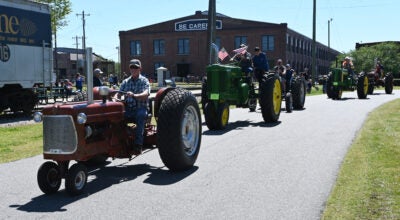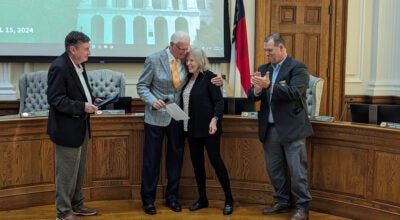Ramsay family giving painting to pilot's family
Published 12:00 am Thursday, July 28, 2011
The family of the late John E. Ramsay, noted Salisbury architect and civic leader, will unveil a surprising painting with ties to a 70-year-old mystery, when they donate the painting to a Dallas, Texas, family Saturday.
The painting by then Lt. Ramsay, a World War II Naval officer and artist, depicts U.S. Marine Corps pilot 1st Lt. Herman H. Spoede II entering his fighter plane just hours before disappearing on July 3, 1943.
The son and grandson of Ramsay will make a surprise presentation of the painting to the sole surviving brother of Herman H. Spoede II, Saturday, at the Four Seasons Hotel and Resort in Las Colinas in the Dallas area.
On July 3, 1943, Spoede departed Guadalcanal in his F4U Vought Corsair. Spoede, along with fellow members of the VMF-213 Hellhawks squadron, were conducting a raid on Rendovain the Pacific.
During the return flight, Spoede was separated from the squadron by a thunderstorm and disappeared. The only notice that Spoede’s parents received was that he was missing in action and that he “failed to return from a routine flying mission in the Solomon Islands area on July 3, 1943.”
For months, Spoede’s letters, written before his disappearance, continued to arrive. Each fostered hope that he might have lived, but also prolonged his parents’ grief. Rumors, and reports of Japanese soldiers surrendering after decades of hiding, contributed to the uncertainty.
With no new evidence, the Marines changed his status to Officially Declared Dead on July 4, 1944.
For decades, the Spoede family learned only sparse details about Herman. A family member working in the Pentagon in the ’90s obtained a copy of VMF-213’s official war diary. A website dedicated to the squadron made it possible to connect survivors and family members. A surviving squadron member, the last to talk to Herman on the radio before he disappeared, called Herman’s surviving brother a few years ago.
Then, Ramsay’s son, John E. Ramsay Jr., contacted Spoede’s surviving relatives with more startling information.
During World War II, Ramsay had served as a Naval Intelligence Officer in the Pacific, and had been stationed on Guadalcanal on the date of Spoede’s disappearance. An architect by training and an amateur artist, Ramsay, on July 3, 1943, was painting one of the Corsairs of VMF-213 during his off-duty hours.
While Ramsay was painting, the squadron was launched on a combat mission. As Spoede climbed into the cockpit of his fighter, Ramsay quickly made a sketch. Ramsay finished the painting while the squadron was in the air.
That evening Ramsay waited by the runway to present the painting to Spoede, but he never arrived. Several days of searching found no sign of the missing pilot.
Ramsay kept the painting, and it was always hanging in his home or office. Nearly everyone who saw the painting would ask about its history. A copy is currently posted on the National Constitution Center website http://constitutioncenter.org/artoftheamericansoldier/.
Ramsay went on to become a Fellow in the American Institute of Architects and a leading proponent of modernist design in North Carolina until his death in 1991. He also was a Salisbury City Council member.
The painting is titled “Thunder Head,” an apparent reference to the role of storm clouds in Spoede’s disappearance.
Ramsay apparently never knew Spoede or his name, but his grandson was able to connect the dots and determine that it was a painting of Spoede since he was the only member of the Hell Hawks to disappear in a thunderhead on July 3, 1943.
“While this painting means a lot to our family, we really think it belongs with the family of Herman Spoede,” said John Ramsay Jr. “It was my father’s intention to give this historic piece of art to Mr. Spoede when he first painted it. We are simply fulfilling that intent.”
On Saturday, John E. Ramsay Jr. and Kerr C. Ramsay (Ramsay’s grandson) will make a presentation of the painting to Robert William Spoede, the youngest and only surviving brother of Herman Spoede. All three of the Spoede brothers served in the military during World War II.
“This painting really gives new life to Herman Spoede,” said David Spoede, Herman Spoede’s nephew and Robert Spoede’s son. “I grew up with stories about him, but to learn something new about him 70 years later is incredible. We are so thankful to the generosity of the Ramsay family and will treasure this painting. I know that this will mean so much to my dad.”
Herman Spoede was born and raised in Wallis, Texas, a small town in south central Texas that his great-grandfather had founded. He was the oldest son of three boys, and was named after his father.
Spoede briefly attended Texas A&M University. However, after taking a flying lesson, Spoede became enamored with flying and left A&M to pursue aviation full time.
When World War II started, he immediately enlisted in the Marine Corps to become a fighter pilot.




